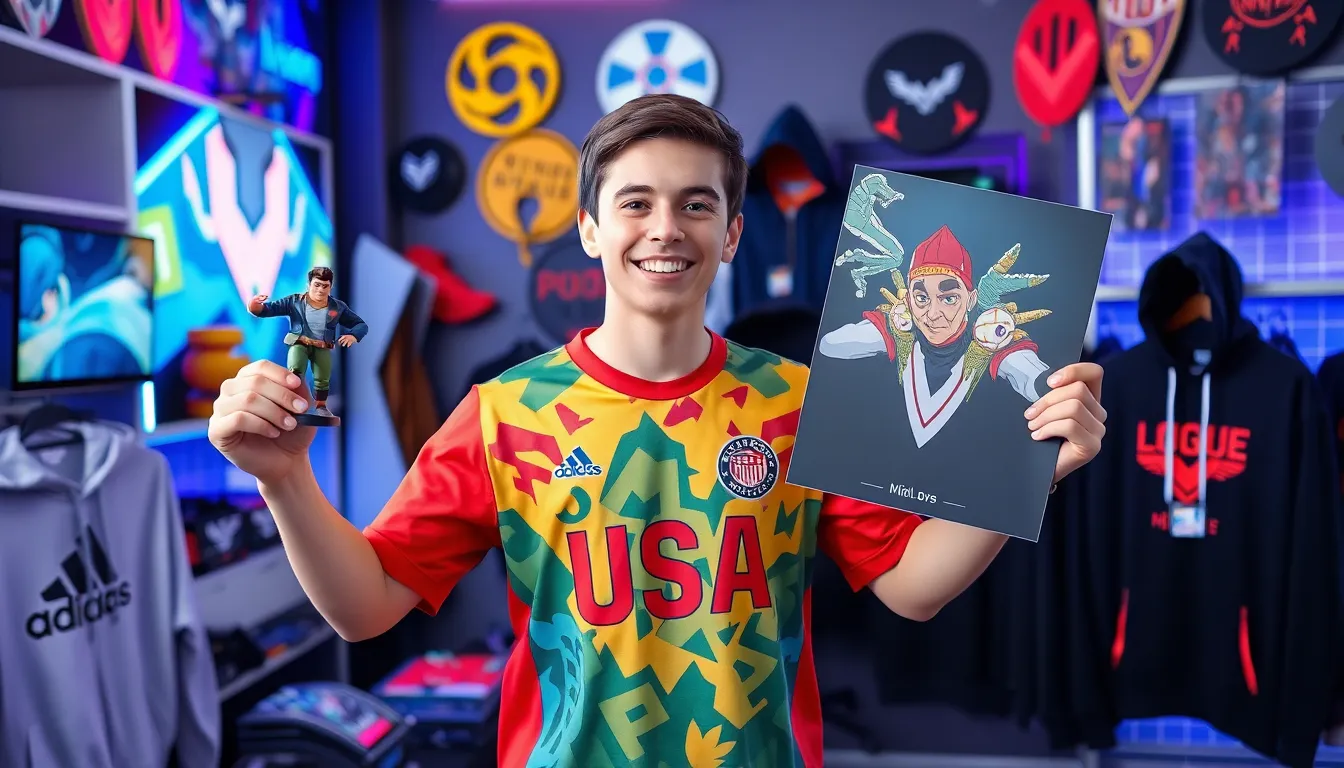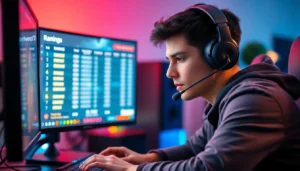Esports isn’t just about the thrill of competition; it’s also a booming marketplace where fans can deck themselves out in their favorite team’s gear. Imagine strutting into your local café sporting a hoodie that screams “I’m a pro gamer!” while sipping on your artisanal coffee. That’s right—esports merchandise sales have skyrocketed, turning casual fans into walking billboards for their favorite teams.
From stylish jerseys to quirky collectibles, the options are endless. Gamers aren’t just playing; they’re making a statement. As the industry grows, so does the opportunity for fans to express their passion in style. Dive into the world of esports merchandise sales, where every purchase is a chance to level up your fandom and look good doing it. Who said you can’t be both stylish and a couch potato?
Table of Contents
ToggleOverview of Esports Merchandise Sales
The esports merchandise market is growing rapidly, reflecting the increasing popularity of competitive gaming. Fans now support their teams by purchasing jerseys, hats, and collectibles that showcase their allegiance. Sales figures for esports merchandise reached approximately $1.1 billion in 2021, with projected growth expected to surpass $2 billion by 2025.
Shirts that feature team logos and player names serve as everyday apparel. Hoodies, another popular merchandise item, offer both comfort and a way to display team spirit. Additionally, collectibles such as action figures and trading cards attract dedicated fans eager to own memorabilia. Consumers often seek limited-edition releases, which enhance the perceived value of these items.
Market analysis indicates that younger demographics are the driving force behind these sales. Gamers aged 18 to 34 represent a significant portion of consumers, emphasizing the importance of engaging with this audience. Retailers are now focusing on creating unique, quality merchandise that resonates with fans’ identities and preferences.
Partnerships between esports teams and brands facilitate exclusive merchandise lines. Collaborations with popular clothing brands often yield limited-time offers that excite fans and drive sales. Online platforms, including team specific websites and popular marketplaces like Amazon, play crucial roles in merchandise distribution, catering to the global fanbase.
Revenue streams from esports merchandise significantly contribute to overall team income. Revenues generated from sales help fund tournaments, player salaries, and team development initiatives. As the esports industry continues to expand, merchandise sales will likely remain a vital component of its economic infrastructure.
Current Trends in Esports Merchandise

Sales of esports merchandise reflect distinct trends shaped by consumer preferences and market forces. Fans engage deeply with their favorite teams, supporting them through varied merchandise choices.
Popular Merchandise Categories
Jerseys represent a top-selling item in the esports merchandise market, allowing fans to wear their allegiance. Collectibles such as figures and posters appeal to the desire for unique memorabilia. Hoodies and shirts also gain popularity, offering comfort and style that resonate with gamers. Limited-edition releases create urgency, prompting fans to make quick purchases, while partnerships between teams and well-known brands introduce exclusive items that further attract buyers.
Demographics of Buyers
The primary buyers of esports merchandise skew young, particularly those aged 18 to 34. This demographic appreciates the emotional connection to gaming, driving a preference for stylish team gear. Males often lead purchases, though female interest continues to grow. Research indicates that 70% of esports fans actively seek new merchandise, reflecting a high level of engagement with their preferred teams. Fans tend to prioritize quality and uniqueness, indicating a trend toward more specialized merchandise.
Impact of Esports on Merchandise Sales
Esports significantly influences merchandise sales, creating opportunities for teams and brands alike. Increased visibility enhances consumer engagement and generates higher sales across various products.
Sponsorship and Branding
Sponsorship plays a vital role in esports merchandise sales. Brands collaborate with teams to create unique merchandise that resonates with fans. Exclusive merchandise drives demand and strengthens brand loyalty. Successful partnerships elevate visibility and increase sales, with high-profile sponsors contributing to merchandise growth. Authentic branding ensures fans feel connected to their favorite teams, encouraging purchases. Collaborative releases leverage each party’s strengths, resulting in innovative products and heightened visibility.
Online vs. Offline Sales Channels
Online sales channels dominate the esports merchandise landscape. E-commerce platforms provide fans with easy access to products, allowing instant purchases. Statistics indicate that over 60% of merchandise sales occur online, often featuring exclusive items. Social media promotion amplifies online reach, creating buzz around new releases. In contrast, offline channels include events and tournaments, fostering a hands-on experience for fans. Pop-up shops and merchandise booths at events enhance emotional connections with teams. Despite the rise of online sales, offline experiences remain essential for engaging fans and driving impulse purchases.
Challenges in the Esports Merchandise Market
The esports merchandise market faces several challenges that can impact growth and sales.
Counterfeit Products
Counterfeit merchandise poses a significant threat to brand integrity and revenue. These imitation products often lead to consumer distrust, harming the reputation of legitimate teams and brands. Fans may accidentally purchase these fakes, which lack the quality assurance associated with official merchandise. Statistics reveal that 25% of consumers unknowingly buy counterfeit items, making education on authentic products crucial. Teams and brands must combat this issue by enhancing anti-counterfeit measures and promoting awareness campaigns to help fans distinguish legitimate items from fakes.
Market Saturation
Market saturation emerges as another challenge, with numerous brands and products vying for consumer attention. The rapid influx of merchandise options can overwhelm fans, leading to choice paralysis. Research shows that the number of esports merchandise offerings increased by 30% year-over-year, reflecting intense competition. Consequently, brands find it difficult to stand out and often resort to price cuts to attract buyers. Maintaining unique and high-quality products becomes essential for teams aiming to stay relevant in this crowded market. Prioritizing collaborations and limited-edition releases can also help brands differentiate themselves amid saturation.
Future Projections for Esports Merchandise Sales
Research indicates that esports merchandise sales will continue to surge, with projections estimating growth to exceed $2 billion by 2025. A substantial increase driven primarily by young consumers aged 18 to 34 supports this trend. These fans, eager to showcase their loyalty, actively seek top-quality items that reflect their passion.
Limited-edition merchandise plays a crucial role in this growth trajectory. The popularity of exclusive releases not only boosts sales but also fosters brand loyalty among fans. Partnerships between teams and established brands enhance this trend, as unique collaborations create merchandise that resonates deeply with supporters.
Sponsorship commitments will likely expand as esports prominence escalates. Such collaborations frequently yield merchandise lines tailored to specific fanbases, maximizing engagement and driving revenue. This alignment positions teams favorably within a competitive landscape.
Online retailers will continue to dominate the sales environment, with over 60% of transactions occurring through digital platforms. Convenience and accessibility are key factors behind this shift, allowing fans to purchase items with ease. Social media channels amplify this reach, drawing in potential buyers and fostering a sense of community among fans.
Despite these promising projections, challenges remain. The threat of counterfeit products still looms large, with 25% of consumers unknowingly purchasing fakes. Educating fans about authentic merchandise will be essential for maintaining trust in brands.
Saturation in the market poses additional concerns, as brands grapple with a 30% year-over-year increase in product offerings. Prioritizing unique, high-quality merchandise will be vital to capturing consumer interest and overcoming choice paralysis among potential buyers.
The esports merchandise market is set for remarkable growth as fans continue to embrace unique ways to express their loyalty. With a focus on quality and exclusivity, brands that prioritize authentic merchandise will thrive in this competitive landscape. The strong online presence combined with engaging offline experiences ensures that fans remain connected to their favorite teams.
As the industry evolves, addressing challenges like counterfeit products will be essential for maintaining consumer trust. The future of esports merchandise looks bright with innovative partnerships and limited-edition offerings capturing the attention of a passionate fanbase eager to showcase their support.

